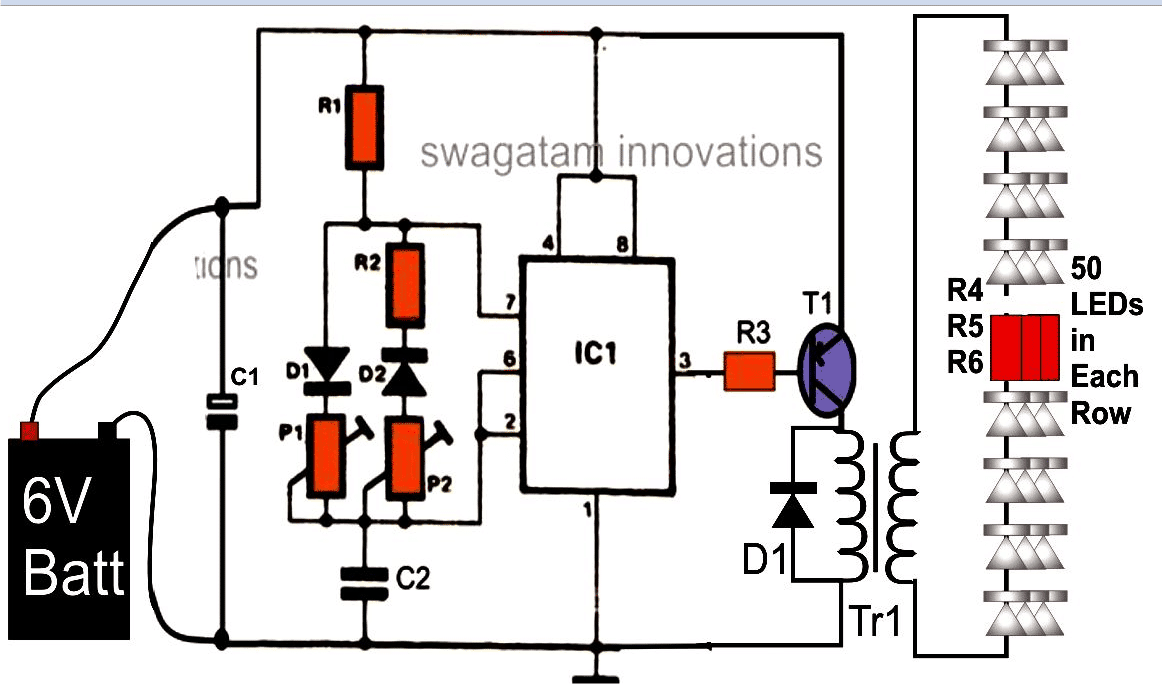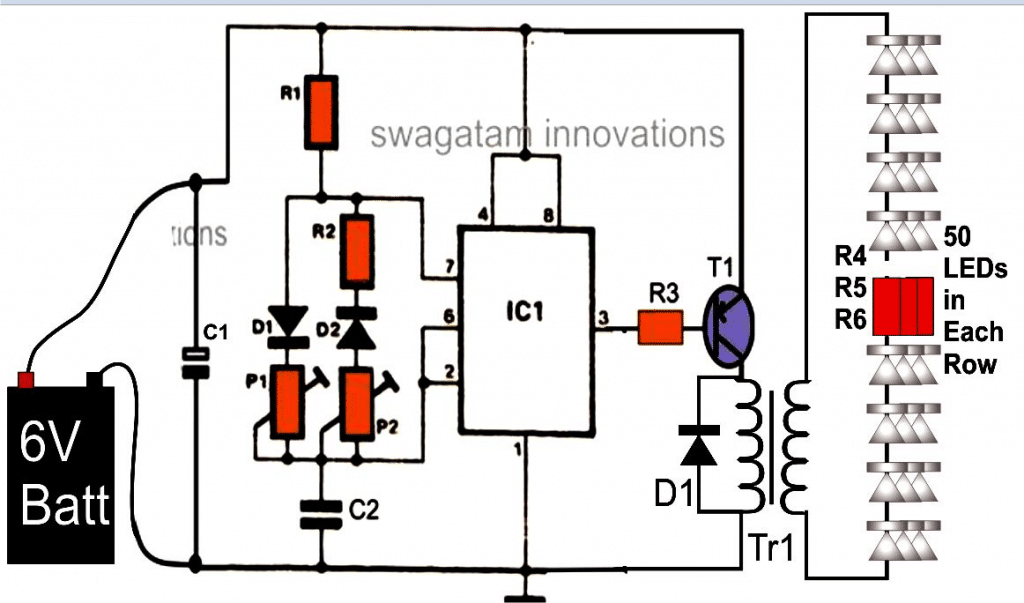In this article I have explained an innovative way of driving more than a hundred white LEDs from a 6 volt battery. The circuit utilizes the IC 555 for driving a step up transformer, whose output is finally used for illuminating the LEDs. A special PWM configuration makes the circuit much power efficient.
Main Stages of the Design
The main stages of this 6V 100 LED pwm driver using IC 555 are an astable multivibrator stage configured with PWM control facility and an output transformer step-up stage.
The pulses generated by the pwm stage is used for dumping and saturating the input winding of the transformer, which get amplified to the specified levels at the output winding of the transformer driving the bunch of LEDs connected there.
Using IC 555 for PWM Control
The IC 555 is wired up in its most usual configuration, as an astable multivibrator.
Everything about the circuit looks pretty common as the pin outs of the IC is configured with its usual format, except for the two diodes and a couple of presets which makes the circuit a bit different from the typical 555 astable set ups.
The inclusion of the two diodes and the presets here enables the control of the pulse formations discretely.
This control of the pulses is termed PWM or pulse width modulation.
The PWM implementation in the circuit can be understood by refering the diagram and with the following points:
Initially when the circuit is powered, pin #2 which is trigger pin of the IC, goes low, with the capacitor in the discharging mode, holding the output low.
Once C2 is fully discharged, flips the output which was initially low to high.
At this point the capacitor C2 begins charging through D1 and P1, until the voltage across C2 reaches 2/3rd of the supply voltage, when pin #6 of the IC is switched, resulting the output and pin #7 to go low yet again.
Circuit Diagram

The above procedure repeats, causing sustained oscillations at the output.
However since the charging and discharging periods of C2 directly corresponds to the output periods of the pulses, it simply means that by varying or controlling the charging and discharging of C2 separately, we should be able to dimension the output pulses correspondingly.
The pots or the presets P1 and P2 are exactly placed for these adjustments and hence constitutes the PWM function.
The PWM application contributes to another important function for the present application.
By suitably optimizing the pulses, we can set the circuit to a most economic position for obtaining optimum brightness from the LEDs at relatively lower battery consumption.
The output from the IC is taken from its pin number three and used for driving as power transistor.
Since the collector of the power transistor is joined to the secondary (low voltage) winding of an ordinary AC-DC transformer, the entire supply voltage is dumped periodically into this section of the transformer inductor.
As anticipated, this pulsed voltage which is forced into the secondary winding induces a proportional magnitude of voltage into the primary winding of the transformer.
The process is entirely reversed as compared to the situation when the transformer is used with its normal AC-DC adapter applications.
The voltage is stepped-up rather than stepping down to about 230 volts which happens to be its normal primary winding specification.
This stepped up voltage available at the free winding ends of the transformer is actually used for driving a large number of LEDs which are wired up through long series and a few parallel connections.
How the Circuit is Powered
The proposed 6V 100 LED Driver circuit is powered by a SMF battery of 6 volts and around 4 Ah of capacity.
The power of the battery may appear to be quite high but the parameters are not suitable for driving a very high number of LEDs.
I have already discussed about this issue in number of my earlier posts.
Basically LEDs are voltage driven devices and not current, i.e. if the applied voltage satisfies the forward voltage, the LEDs get illuminated with nominal current levels and on the contrary if the voltage does not match the LEDs forward voltage spec, then the LED refuses to light even if the applied current is made 100 times the saturating value.
Another factor associated with LEDs is that, these devices can be run in series with its minimum specified current levels.
That means if the voltage of the series matches the total forward voltage of the series, the current required would be just around the magnitude that would be required for lighting a single LED.
This parameter rather feature with LEDs wiring becomes imperative when the source voltage is quite low.
Thus for driving many numbers of LEDs as discussed for the proposed circuit from a 6 volts source, the above rule becomes necessary and has been effectively employed.
Parts List
The following parts will be required for making the above PWM LED driver circuit:
All the resistors are ¼ watt unless otherwise specified.
- R1 , R2 = 1 K = 2
- R3 = 10 K = 1
- R4, R5, R6 = 100 Ohms = 3
- P1, P2 = 100 K = 2
- C1 = 10 uF / 25 V = 1
- C2 = 0.001 uF, ceramic disc = 1
- IC = LM 555 = 1
- T1 = TIP 127 = 1
- TR1 = sec. – 0 – 6 V, prim. – 0 – 230 V, 500mA = 1
- Battery – 6 volts, 4 AH, SUNCA type =1
- PCB – Veroboard, cut according to the required size = 1
- LEDs – 5 mm, white, high bright, high-efficiency.
- CAUTION - THE CIRCUIT IS BASED ON THE ASSUMPTIONS MADE BY THE AUTHOR AND HAS NOT BEEN PRACTICALLY VERIFIED, VIEWERS DISCRETION IS ADVISED.
